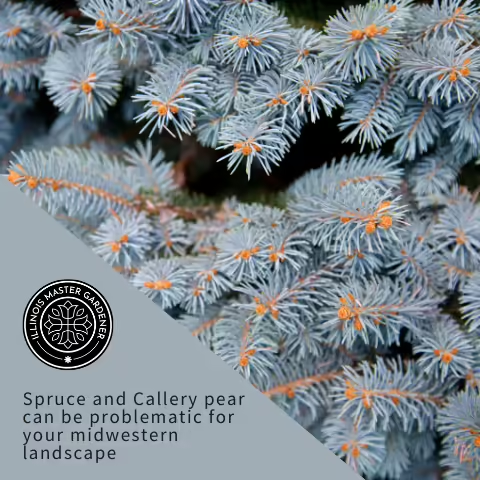Fall is an excellent time to plant trees. While you may be tempted to plant the aesthetically pleasing Colorado Blue Spruce and Callery (ornamental) pear, these trees should be avoided in the Midwest. A variety of reasons make them unsuitable.
Colorado Blue Spruce (Picea pungens) trees are not ideal for our climate. Being native to the cool, dry climate of the western U.S. mountains, they do not adapt well to our hot, humid summers. Mountainous soils drain fast, unlike our moisture-retaining cropland. While life expectancy in the Rocky Mountains is 600 – 800 years, in our landscapes it is 30 – 40 years. Quite a difference!
Having “wet feet” and being surrounded by humid air leads to disease for blue spruces, usually from bacteria. Once you notice the needles turning brown, then whole branches, it is too late to do anything effective to save the tree.
Callery pear (Pyrus calleryana) thrives in our climate but is problematic for other reasons. They are lovely trees especially during their almost month-long blooming time in early spring. Their perfect pear-like shape, called pyramidal in garden talk, and their dark green leaves make them a popular landscape tree. Ornamental pears are also disease and insect-free, for the most part. So, what is the problem?
The most serious problem is while sterile when sold, they can cross-pollinate with other varieties and spread beyond the boundaries of our yards. Thanks to birds eating and dispersing the seeds, they are showing up in the woods and along highways, in the process becoming invasive.
The second problem stems from their pyramidal shape with close-packed up-right branches resulting in weak branch attachment. High winds and ice storms break the branches, peeling them away from the trunk. What was once a very symmetrical tree, becomes an irregular tree with unsightly gaps.
If your blue spruce or callery pear is healthy, I do not recommend removing them. When they fail, take them down and replace them with a different species more suitable to our climate and one that won’t threaten our native environment. Check out these native options.
The Illinois Extension Master Gardeners of Edgar County have been busy answering homeowners’ questions. If you need help, call us at 217-465-8585.
SOURCE: Jan Phipps, Master Gardener, Edgar County
ABOUT EXTENSION: Illinois Extension leads public outreach for University of Illinois by translating research into action plans that allow Illinois families, businesses, and community leaders to solve problems, make informed decisions, and adapt to changes and opportunities.
